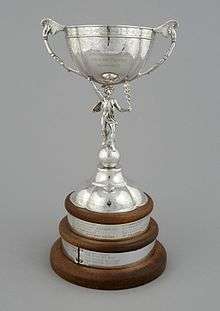British air racing championship
In the early 1980s the British Air Racing Championship was developed with the reformation of the Royal Aero Club Competition Committee into the Royal Aero Club Records Racing and Rally Association, allocating points according to position in the field at the finish of each air race, accumulating throughout a racing season.
History
As soon as aircraft developed to the stage that they would stay airborne for predictable amounts of time, pilots started to pit their skills and aircraft against each other both personally and on a national and international basis. The earliest air races attracted an international audience and large cash prizes were offered for the winners. Perhaps the epitome of this would be the Schneider Trophy. As aircraft became more diverse, handicapping was adopted in Britain to level the playing field. The first handicapped race was held in 1922, sponsored by King George V—the King’s Cup. In 1931 the rules were re-written to allow amateur pilots to compete in standard production aircraft. Those rules still apply today, with some minor modifications and the King’s Cup remains the only air race to receive royal patronage.
Handicapped air racing was a British phenomenon, although latterly the concept has been used to stage air races worldwide.
Racing season

A typical handicapped air racing season comprises some eight venues and 16 races. The maximum points available for a win in each race is 100 on a sliding scale.
The winner of this cumulative championship is known as the British Air Racing Champion and the trophy associated with it is the Jubilee Trophy. This silver cup was originally presented in 1952. The runner-up is awarded the Brian McBride Trophy, a silver bowl on a wooden plinth.
Results
Contemporary winners of the championship are:[1][2][3][4]
- 1952 WPI Fillingham
- 1953 Sqn Ldr James Rush AFC
- 1954 Miss Freydis Leaf
- 1955 JN Somers AFC
- 1956 Flt Lieut HB Iles
- 1957 Flt Lieut HB Iles
- 1958 HAG Smith
- 1959 Capt NT Baldwin AAC
- 1960 Sqn Ldr J DeM Severne
- 1961 SM Aarons
- 1962 D Hartas
- 1963 PG Bannister
- 1964 D Hartas
- 1965 P Blamire
- 1966 JAC Miles
- 1967 J Stewart-Wood
- 1968 RL Ranscombe
- 1969 CBG Masefield
- 1970 J Stewart-Wood
- 1971 FB Miles
- 1972 Frederick Marsh
- 1973 J Behrmann
- 1974 J Behrmann
- 1975 J Behrmann
- 1976 AJ Spiller
- 1977 F Pursglove
- 1978 R Hayter
- 1979 J Smith
- 1980 R Graves
- 1981 J Smith
- 1982 J Stewart-Wood
- 1983 Flt Lieut D Turner
- 1984 Dr I Dalziel
- 1985 GSI Hanks
- 1986 FB Miles
- 1987 PW Crispe
- 1988 KJ Wilson
- 1989 Andrew Brinkley
- 1990 Spencer Flack
- 1991 Derek Simpson
- 1992 Bruce Hook
- 1993 Sqn Ldr M Baker
- 1994 B Hook
- 1995 Bob Willies
- 1996 Sqn Ldr A Austin MBE
- 1997 Paul Moorhead
- 1998 Bert Miles
- 1999 Graham J Banfield
- 2000 Robert Miller
- 2001 M Konstantinovic
- 2001 Ivan H Seach-Allen
- 2002 P Wadsworth
- 2003 Robert Miller
- 2004 John Kelsall
- 2005 Craig Beevers
- 2006 Anthony P Beynon
- 2007 R Callaway-Lewis
- 2008 Alistair Allan
- 2009 Craig Beevers
- 2010 Neil Cooper
- 2011 Geoffrey Boot
- 2012 Gordon Bellerby
- 2013 Martin Gosling
- 2014 Martin Gosling
- 2015 Bob Ellis
- 2016 Mark Turner
References
- ↑ Lewis, Peter. British Racing and Record-Breaking Aircraft. Putnam, 1971, pp. 482-483
- ↑ Records of the Royal Aero Club Records Racing and Rally Association
- ↑ Benjamin, Lewis J. The Tiger Club: 1967-76 v. 2: The Exuberant Years. Cirrus Associates (S.W.), 1999, pp 223 - 224
- ↑ The Royal Aero Club British Aviation Bicentenary Year Book 1984-1985, page 182